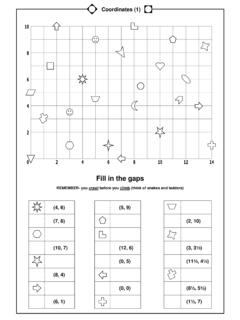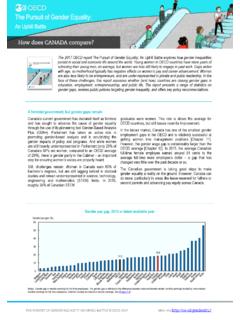Transcription of TECHNICAL ANALYSIS OF GAPS - pearsoncmg.com
1 TECHNICALANALYSIS OF GAPSThis page intentionally left blank TECHNICALANALYSIS OF GAPSIDENTIFYINGPROFITABLEGAPS FORTRADINGJULIER. DAHLQUISTRICHARDJ. BAUER, President, Publisher: Tim MooreAssociate Publisher and Director of Marketing: Amy NeidlingerExecutive Editor: Jim BoydEditorial Assistant: Pamela BolandOperations Specialist: Jodi KemperAssistant Marketing Manager: Megan GraueCover Designer: Alan ClementsManaging Editor: Kristy HartSenior Project Editor: Lori LyonsCopy Editor: Apostrophe Editing ServicesProofreader: Kathy RuizIndexer: Lisa StumpfCompositor: Nonie RatcliffManufacturing Buyer: Dan Uhrig 2012 by Julie R.
2 Dahlquist / Richard J. Bauer, Education, as FT PressUpper Saddle River, New Jersey 07458 This book is sold with the understanding that neither the author nor the publisher isengaged in rendering legal, accounting, or other professional services or advice bypublishing this book. Each individual situation is unique. Thus, if legal or financialadvice or other expert assistance is required in a specific situation, the services of acompetent professional should be sought to ensure that the situation has been evalu-ated carefully and appropriately. The author and the publisher disclaim any liability,loss, or risk resulting directly or indirectly, from the use or application of any of thecontents of this Press offers excellent discounts on this book when ordered in quantity for bulkpurchases or special sales.
3 For more information, please contact Corporate andGovernment Sales, 1-800-382-3419, For sales out-side the , please contact International Sales at charts created with TradeStation. TradeStation Technologies, Inc. All and product names mentioned herein are the trademarks or registeredtrademarks of their respective rights reserved. No part of this book may be reproduced, in any form or by anymeans, without permission in writing from the in the United States of AmericaFirst Printing June 2012 ISBN-10: 0-13-290043-2 ISBN-13: 978-0-13-290043-0 Pearson Education Education Australia PTY, Education Singapore, Pte.
4 Education Asia, Education Canada, Educaci n de Mexico, de Education JapanPearson Education Malaysia, Pte. of Congress Cataloging-in-Publication DataDahlquist, Julie R., 1962- TECHNICAL ANALYSIS of gaps : identifying profitable gaps for trading / Julie , Richard J. Bauer, 978-0-13-290043-0 (hbk. : alk. paper)1. Stocks Charts, diagrams, etc. 2. TECHNICAL ANALYSIS (Investment ANALYSIS ) , Richard J., 1950- II. Title. 2042 dc232012010828To Katherine and SeppThis page intentionally left blank ContentsAbout the Authors .. xiiChapter 1: What Are gaps ?
5 1 Chapter 2: Windows on Candlestick Charts .. 17 Chapter 3: The Occurrence of gaps .. 43 Chapter 4: How to Measure Returns .. 71 Chapter 5: gaps and Previous Price Movement .. 107 Chapter 6: gaps and Volume .. 121 Chapter 7: gaps and Moving Averages.. 139 Chapter 8: gaps and the Market .. 159 Chapter 9: Closing the Gap .. 205 Chapter 10: Putting It All Together .. 219 Index .. 227 AcknowledgmentsWe first started looking at gaps because theyprovide useful illustrations when teachingour students how to read stock hear a news report that their favorite companyjust reported earnings, that a company is being sued, orthat a well-known company, such as Apple, is launch-ing a new product and ask how these events will affectthe price of the stock of the company.
6 These newsevents often trigger sizeable price moves, frequently ona gap. We can introduce the concept of a gap easily andquickly and then use the conversation as a jumping-offpoint for broader discussion of the tools of repeatedly come up during small talk whenpeople find out that we have a background in technicalanalysis. Even individuals who know little about thestock market seem to have heard the adage the gap isalways filled. The two TECHNICAL ANALYSIS terms thatpeople seem to latch on to are head and shoulders and gaps .
7 After engaging in a number of these con-versations, we thought it would be interesting to pursuethis topic a bit more. gaps seem to have captured theattention of the earliest TECHNICAL analysts, but we foundsurprisingly little systematic study of gaps . Much of therecent work in the area of TECHNICAL ANALYSIS has beenbased on complex mathematical models. We thought itwould be a fun and interesting endeavor to investigateone of the simple, basic ideas of TECHNICAL ANALYSIS inmore depth. Thus, a couple of years ago we began the beginning, we thought we would engage in asimple study that would provide some interesting storiesregarding gaps to use in our classrooms.
8 As we startedlooking at gaps , our appreciation for their use as a toolof TECHNICAL ANALYSIS grew and our inquiry grew. In May2011, we were honored as recipients of the MarketTechnicians Association s Charles H. Dow Award inTechnical ANALYSIS for our paper, Analyzing gaps forProfitable Trading Strategies. We realized that in ourpaper we had only been able to scratch the surface ofgaps. Our editor, Jim Boyd, suggested we continue ourinvestigation in the form of a book the result of whichyou are holding in your hands. We are indebted to a number of people who helpedus learn more about gaps and who helped put thisknowledge together in the form of this book.
9 First, weare indebted to Charlie Kirkpatrick for all the supportand assistance he has given us in learning about techni-cal ANALYSIS over the years. His knowledge and patienceare endless. Ellie Kirkpatrick, Charlie s wife, is thegreatest cheerleader anyone could have in their continues to motivate and inspire us. We thank bothCharlie and Ellie for the endless list of things that theyhave done for us and our would like to thank Fred Meissner and HankPruden for their support and encouragement. They areboth stellar examples of the friendliness and warmthexhibited by many in the TECHNICAL ANALYSIS , too, have been especially kind to our to all those who work in the MTA office, espe-cially Tom Silveri, Tim Licitra, and Shane Skwarek.
10 Thisproject has benefited from conversations with membersof the MTA through electronic discussion groups, web-inars, and meetings across the world from Houston toixAcknowledgmentsPrague. A special thanks to Robert Colby and RalphAcampora for answering questions along the , also, to Norgate Investor Services for grantingus permission to publish our results, which were basedon their stock price data marketed as Premium are grateful to the Pearson staff, especially exec-utive editor Jim Boyd, managing editor Kristy Hart, andsenior project editor Lori Lyons for their hard work anddedication in bringing this project to have dedicated this book to our children,Katherine and Sepp.















